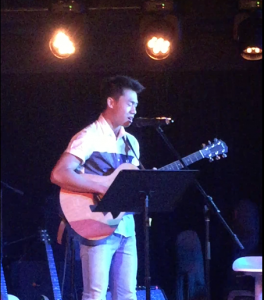Audiences are smart. They know the difference between good and superior. You may have listened to a friend sing and thought, “She’s amazing!” However, you know that she doesn’t have the same kind of talent as Beyonce or any mainstream artist. To understand the difference between a seasoned performer and someone with potential doesn’t take 30+ years of training. As a vocalist, it is good to remember that the audiences’ ear is tuned to the incredible AND the incredibly bad. They may not know exactly why they like or don’t like something, but they can tell. Every entertainer, both good and bad, is communicating with the audience when they perform. Wowing your audience doesn’t always mean singing high notes at full volume. One of the many weapons vocalists have in their arsenal to communicate with their audience is phrasing.
What is Phrasing?
As you might have guessed, phrasing has to do with the phrases we sing throughout the song. A musical phrase is what is sung between two breaths. Phrasing is both creating motion and emotion with each phrase. Good phrasing has everything to do with good breathing. One good example is: “(breath) Oo, I heard it through the grapevine (breath)…” If the breathing is bad, it chops up the phrase and the feel: “(breath) Oo, I heard (breath) it through the grapevine (breath)…” It is easy to hear in your head how the extra breath takes away from the feel. In order to master phrasing, a singer has to first master good breath control. Once a singer knows how to use the breath to control each phrase and carry that breathe to end of the phrase, some fun elements can start to happen.

The First and Last Notes
The first and last notes of each phrase are the most important. Why? When I was in university, one of my choral professors told us that singing is like dominoes. If the first note is bad, the rest of the phrase will be bad. Conversely, if the first note is good, the phrase will be good. It’s always important to remember that the first note sets up your technique. It is the first step on your run.
The last note is about trust. If the last note is executed artistically, it gets the audience to trust you. It helps them to think “Oh, she’s got this!” and allows them to relax and let you take them on a journey. There are so many little things you can do to energize the last note of a phrase but a good rule of thumb is to always remember that the first note helps you. The last note helps them.
Crescendo, Decrescendo and the Bubble
A crescendo is a small increase in volume. It can be used on one note, throughout several notes, or slowly through an entire phrase. Crescendo increases the intensity of any phrase and tells the audience that an emotional shift is coming. Imagine someone getting angry. They might start off by mumbling about something that bothers them and slowly their voice raises in volume until they are yelling about it. The emotion and passion involved in this scenario can be the same with a song. Whether you are singing about love, death, happiness, or sadness, the crescendo can bring an audience with you on a intense journey.
Decrescendos are the polar opposite of crescendos. Instead of increasing in volume, they decrease. Although it sounds easier, the decrescendo can be difficult to control. The lack of air pressure to decrease the volume can sometimes cause the vocal cords to crack or lose phonation. Proper control from the diaphragm is key in maintaining the right amount of pressure. The great thing about decrescendos is the surprise element. The audience rarely sees them coming and when they do, they know that the singer has the wheel.
One of the most commonly used phrasing techniques is what I call a bubble. A bubble is a small crescendo followed by a small decrescendo, creating a slight lift in the sound. The reason it’s called a bubble is because, musically written, it looks like this: <>. This skill can energize any phrase and get the audience on your side. I use the bubble with many of my students as it is an easy way to develop good phrasing. By using the breath to control and lift the volume and then reducing the volume, it gives the song motion and tells the audience that you are in complete control.
It Sounds Complicated to Me?
Sometimes just getting out there and singing is the best technique of all. However, if you have been training for a while and feel your performance isn’t improving, try incorporating phrasing into your songs. It will give the music motion and passion but most importantly, it will bring the audience into your world.
©2018 SeanyMac Studios, Sean Oliver All rights reserved.
